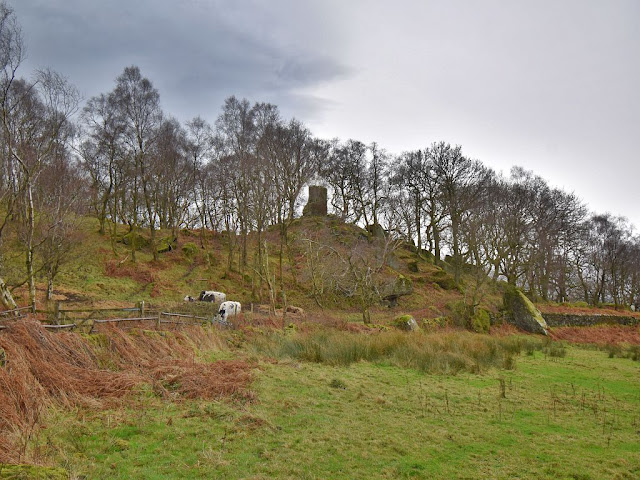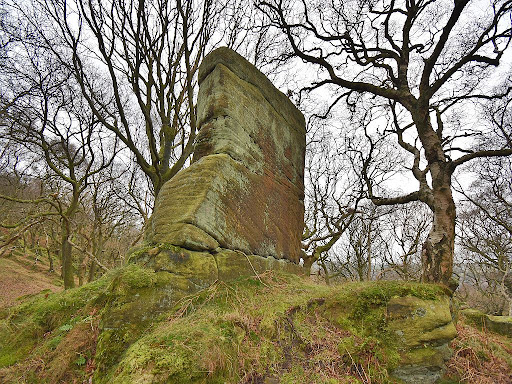The Noon Stone is a 4 metre high rectangular block of stone standing on a low hill 1/4 of a mile to the south of Brimham Rocks, and 8 miles to the north west of Harrogate.
Today the rock stands amongst trees planted on the hill side, but in the past it stood alone on the ridge, and formed a conspicuous local landmark.
The travel writer Thomas Pennant visited the unusual rock formations at Brimham Rocks in the summer of 1777, and wrote ..."On my arrival on the summit of the hill, the seat of wonders, my astonishment was unspeakable ; the whole was new to me; a flat covered with stones of forms the most singular, and many of sizes most stupendous." (Pennant, 1804).
After describing several of the oddly shaped outcrops in the main group, he noted ... "I finally take leave of these wonderous phenomena by saying, that opposite to a weaver's-house, beneath the crags, is a round small mount, on which is a rectangular natural stone, quite erect, and, at a distance, taken for a tower ; it is about thirteen feet broad, and about three feet thick. The country people call it the Noon-Stone as the meridian is made known to them by the shining of the sun on it."

|
|
The Noon Stone amongst the trees on the hill |
A few years after Pennant's visit, Major Hayman Rooke also made several engravings of the Brimham Rocks, including the Noon Stone. He described it ... "No 10. is a west view of a rock, called by the country people Noonstone, from its casting a shadow on a cottage at 12 o’clock. On Midsummer Eve fires are lighted on the side (a). Its situation is apposite for this purpose, being on the edge of a hill commanding an extensive view. This custom is of the most remote antiquity."
The Weaver's cottage mentioned by these authors appears to be the small
stone built building in the field below the Noon Stone, and part of High Wood
Farm, which is located 150m due north of the stone. As the sun is always due
south at mid day (noon), people on the farm would know that it was midday when
the sun was above the stone pillar on the hill. How useful this was as a time
indicator would depend on the weather, as on over cast days the sun is often
obscured by clouds (!).

|
|
Looking north from the Noon Stone to the Weaver's Cottage and the
farm |
The reference to the Noon Stone casting a shadow over the Weaver's
Cottage also seemed a little fanciful, but a visit in mid December 2022 found
the sun passing just above the Noon stone, and casting a shadow. This can only
take place during the winter months when the sun is very low in the sky, and
at the winter solstice the sun does actually disappear behind the top of the
rock at midday. The Weaver's Cottage appears to be located at just the right
distance from the hill and stone for this 'eclipse' to be only visible around
the winter solstice days.

|
| The midday sun over the Noon Stone - December 15th |
This midwinter 'eclipse' and shadow phenomena, along with the midsummer solstice fires, and noon indicator, begins to suggest that this pillar of rock standing on the hill top, may have had a much wider solar significance. It is also worth noting that the long axis of the rock itself points to the south west - in the direction of the winter solstice sunset. This natural, but significant alignment, marking the turning of the year, was perhaps the origin of the stones solar connections.

|
| The Noon Stone's shadow across the window of the Weaver's cottage |
That the farm was built exactly due north of the Noon Stone suggests that the rock was already known for marking the sun's position. While the midsummer eve fires that took place next to the stone also linked it with much older fire festival customs. Bonfires were lit all over the country at midsummer in the belief that the fires drove away any bad or evil spirits lingering about. Burning torches were carried around fields and farm buildings, as well as being passed over the backs of farm animals, before the torches were thrown onto the main fire. When the flames had died down, people would also jump across the fire or walk over the embers. With the spirits that caused illness, disease, and general bad luck cleansed by the flames, the land and its people could hopefully prosper.
The summer solstice fires at the Noon Stone suggests that this tall pillar of rock may have been associated with the sun long before the farm was built to the north of it. Local tradition linked the stone with the longest day of the year (most hours of daylight), when the sun reaches its highest point in the sky. With the sun at the peak of its power, the light and flames from the fires kindled on that day were perhaps believed to share the sun's potency.
It is quite possible that the farm was intentionally built where it is in the belief that its relationship to the 'sun stone' would be beneficial to the farm. The farm occupies a fairly level, but narrow terrace which runs north along the hillside as it drops down into Fell Beck valley. 400m further north along this terrace, another farm (Druids Cave Farm) appears to have been built alongside a stone circle and cairn field, which were noted by Hayman Rooke during his visit (See Brimham's lost stone circle). Only a large cup and ring marked rock survives on the site today, but this again suggests an old belief that the presence of these ancient stones were of benefit to the farm. At Dacre on the opposite side of the Nidd valley, a large cup and ring marked rock known locally as the Fertility Stone, still sits in a pasture field where cattle graze.
As the stone circle and cairns appear to have been cleared away on Druids Cave Farm some time around 1800, perhaps similar prehistoric remains were also cleared from the land below the Noon Stone? With a Bronze Age ritual site only a few hundred metres to the north of the Noon Stone, it would be no surprise to find that this pillar of stone pointing towards the winter solstice sunset, and creating an eclipse / shadow effect, would also be regarded as a special location. In later times the stones solar significance was still noted, and fires were lit by the rock on midsummers eve. Then, as farming spread further up the valley sides, one farm was setup literally in the shadow of the Noon Stone, perhaps with one eye on the old beliefs regarding the fertile powers of the ancient stones.
ExtraThoughts
The hillside location of the Noon
Stone enabled the midsummer fire to be visible along a section of the Nidd valley,
and westward to the high ground around Greenhow Hill. To the south-west there
also seems to be a line of sight to Beamsley Beacon in Wharfedale, so a chain
of midsummer fires may have been visible along both river valleys.
References
Pennant, T. (1804) A Tour from Alston Moor to Harrowgate and Brimham
Rocks.
Rooke, H. (1787) Archaeologia Vol 8

|
| The 'Weaver's Cottage' below the Noon Stone |

|
|
What the Weaver saw..... |





Post a Comment